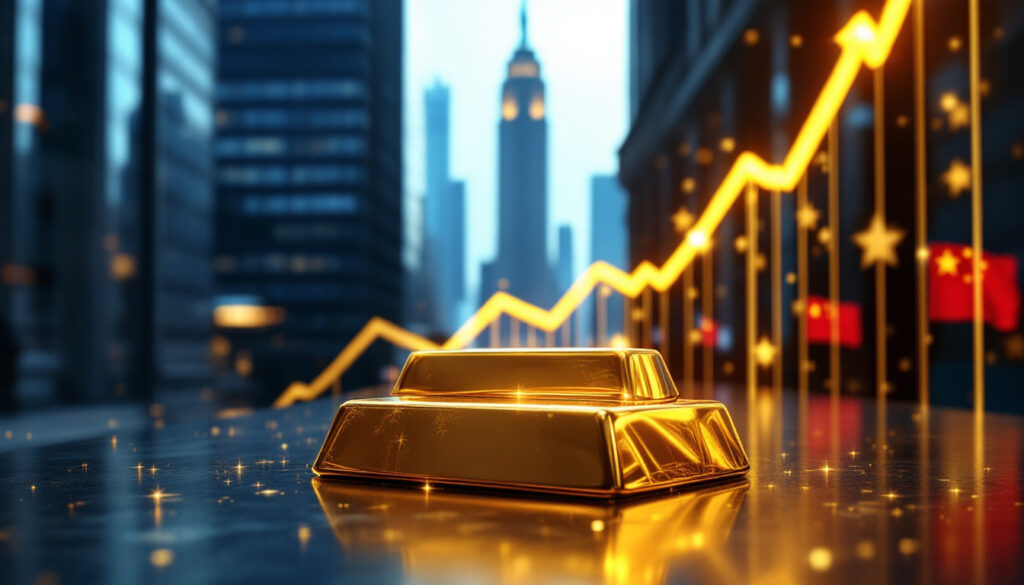Why Is Gold Reaching Record Prices in 2025?
Gold prices continue to surge in 2025, with Goldman Sachs predicting a remarkable climb to US$3,700 per ounce by year-end. This rally represents one of the most significant bull markets for the precious metal in recent history, driven by a complex interplay of global economic factors.
The Perfect Storm of Economic Factors
Multiple catalysts have aligned to create ideal conditions for gold's dramatic price appreciation. Global economic uncertainty has intensified throughout 2025, pushing investors toward safe-haven assets. The Trump administration's tariff policies have introduced significant market volatility, creating an environment where investors seek stability.
According to Goldman Sachs commodities strategist Lina Thomas, "Uncertainty over the Trump administration's tariffs and broader economic concerns are major factors driving investors toward gold." This sentiment reflects the market's growing anxiety about potential trade disruptions and their impact on global growth.
Perhaps most significantly, a structural shift in central bank demand has emerged, particularly from emerging markets. Central bank gold purchases have increased fivefold since 2022, representing unprecedented institutional buying pressure. This dramatic surge began after Western nations froze approximately $300 billion in Russian foreign assets, prompting central banks worldwide to reassess their reserve strategies.
ETF holdings have also begun to increase as recession concerns grow, adding another layer of demand to an already tight market. This combination of institutional and retail investment has created sustained upward pressure on gold prices.
Key Price Targets and Timelines
Goldman Sachs has established a clear trajectory for gold price forecast, projecting a steady climb to US$3,700 per ounce by December 2025 as their base case scenario. However, their analysis includes alternative outcomes based on changing economic conditions.
In a recession scenario, Goldman forecasts a potential spike to US$3,880 per ounce, reflecting gold's historical tendency to outperform during economic downturns. Importantly, Goldman Sachs economists have recently revised their US recession probability assessment to 35%, down from their previous estimate of 45%.
This improved economic outlook stems from progress in trade policy negotiations, which has somewhat reduced immediate recession concerns. Nevertheless, the significant possibility of economic contraction continues to support gold's appeal as both a defensive asset and inflation hedge gold.
How Are Central Banks Transforming the Gold Market?
Central banks have emerged as the dominant force reshaping the gold market in 2025. Their purchasing patterns represent a fundamental shift in global reserve management strategies, with potentially long-lasting implications for gold prices.
The Russia-Ukraine Turning Point
The Western freezing of Russian foreign assets marked a critical turning point in central bank strategy. This unprecedented action against a major economy sent shockwaves through the global financial system, particularly among nations that might find themselves at odds with Western powers.
"The decision to freeze Russian assets fundamentally altered how central banks view their reserves," explains Thomas. "Physical gold, which cannot be sanctioned or digitally seized, suddenly became much more attractive."
This new reality has transformed central bank behavior, with purchases increasing fivefold since 2022. Emerging market central banks, in particular, have been reassessing their reserve asset allocation policies, showing a growing preference for physical gold over currency-based reserves that could potentially be frozen or devalued.
The Emerging Markets Gold Gap
A significant disparity exists between developed and emerging economies regarding gold reserves. China currently holds less than 10% of its reserves in gold, creating substantial room for increased allocation. By contrast, developed nations like the US, Germany, France, and Italy hold approximately 70% or more of their reserves in gold.
"The high gold allocations in Western nations are largely a legacy of the gold standard era," notes Thomas. "Emerging markets have historically maintained much lower percentages."
The global average of reserves in gold stands at roughly 20%, creating a benchmark that many emerging economies seem to be targeting. Goldman Sachs identifies this 20% level as a "plausible medium-term target" for large emerging central banks.
This gap represents enormous potential demand if emerging markets move toward the global average holdings. China alone would need to purchase thousands of tonnes to reach the 20% threshold, potentially supporting higher gold market surge for years to come.
Key Insight: If China increased its gold reserves from current levels to 20%, it would require gold purchases equivalent to approximately one year of global mine production. This structural demand shift could maintain upward pressure on prices regardless of short-term market fluctuations.
What's Driving Investor Sentiment in the Gold Market?
While central bank buying has dominated headlines, investor sentiment has begun playing an increasingly important role in gold's price trajectory throughout 2025.
Economic Uncertainty as a Catalyst
Investors have been steadily increasing their gold holdings since March 2025, reflecting growing market concerns about broader economic health. The uncertainty surrounding Trump administration policies, particularly regarding tariffs and international trade, has contributed significantly to this cautious positioning.
"During periods of uncertainty, traders temporarily park their money in gold," explains Goldman's Thomas. "When clarity returns, we often see these positions unwound and prices stabilize or decline."
This pattern of volatility driving temporary capital "parking" in gold assets has been evident throughout 2025. However, unlike previous cycles, the current wave of investment appears to have more staying power, supported by persistent concerns about inflation, currency debasement, and economic fragility.
The Growing Role of ETFs
Exchange-traded funds have become increasingly important price drivers in the gold market. These investment vehicles allow retail and institutional investors to gain gold exposure without the logistical challenges of physical ownership, making them particularly responsive to changing market sentiment.
ETF holdings historically correlate strongly with recession fears. During periods of economic stress, these funds typically experience significant inflows as investors seek safe-haven assets. Conversely, when economic conditions improve, outflows often occur as capital rotates back toward risk assets.
Current ETF inflows have begun to supplement central bank demand, creating multiple sources of buying pressure. Goldman Sachs analysts note the potential for accelerated ETF growth if economic conditions deteriorate, particularly in a recession scenario.
- ETF inflows typically lead price movements by 1-2 months
- Retail investor participation increases during periods of price momentum
- Institutional allocations tend to be more strategic and longer-term
- Current ETF positioning remains below historical peaks, suggesting room for growth
How Would a US Recession Impact Gold Prices?
The possibility of a US recession remains a critical factor in Goldman Sachs' gold price forecast, with significant implications for potential upside beyond their base case scenario.
Goldman Sachs Recession Scenario Analysis
Goldman's base case projects gold reaching US$3,700 per ounce by the end of 2025. However, their recession scenario analysis suggests a potential spike to US$3,880 per ounce if economic conditions deteriorate significantly.
The firm's economists currently assess the probability of a US recession at 35%, an improvement from their previous assessment of 45%. This reduced risk reflects signs of progress on trade policy negotiations and resilient economic data in recent months.
"While recession risks have moderated somewhat, the probability remains elevated compared to historical norms," notes Thomas. "Any significant deterioration in economic indicators could quickly reignite recession concerns and accelerate gold buying."
Goldman's analysis suggests that a recession scenario would likely trigger substantial ETF inflows as investors seek safe-haven assets, potentially driving prices beyond their current targets.
Historical Recession-Gold Price Correlations
Gold has typically outperformed during economic downturns, reinforcing its status as a safe-haven asset. During periods of market stress, capital tends to flow toward perceived safety, benefiting gold and other defensive assets.
Physical gold is particularly valued during recessions as a hedge against currency devaluation. When central banks implement expansionary monetary policies to combat economic contraction, concerns about currency debasement often drive investors toward hard assets like gold.
ETF inflows accelerate significantly during recessionary periods, as both retail and institutional investors increase their allocations to defensive assets. This pattern has been consistent across multiple economic cycles and appears likely to repeat if recession concerns intensify.
Market Perspective: While gold has historically performed well during recessions, the magnitude of price appreciation varies significantly based on monetary policy responses, inflation expectations, and the severity of economic contraction.
What Are the Key Factors to Monitor for Gold Investors?
Investors tracking gold's potential path to Goldman's US$3,700 target should monitor several critical indicators that could influence price action throughout 2025 and beyond.
Critical Market Indicators
Central bank purchase volumes remain perhaps the most important metric to track, particularly from emerging markets. Continued buying at current elevated levels would provide strong support for Goldman's bullish price targets.
ETF inflow/outflow patterns serve as an early indicator of changing investor sentiment. Accelerating inflows would suggest broadening market participation beyond central banks, potentially supporting higher prices.
US dollar strength/weakness maintains an inverse relationship with gold prices. Dollar weakness typically supports gold appreciation, while significant dollar strengthening could create headwinds for the precious metal.
Inflation expectations and real interest rates directly impact gold's appeal as an alternative to yield-bearing assets. Lower or negative real rates enhance gold's relative attractiveness, while rising real yields tend to pressure prices.
Geopolitical developments, especially US-China trade relations, continue to influence gold through their impact on risk sentiment and economic expectations. Escalating tensions typically benefit gold, while improving relations could reduce safe-haven demand.
Potential Market Disruptors
Several factors could potentially disrupt Goldman's price trajectory for gold:
Unexpected shifts in Federal Reserve monetary policy could significantly impact gold prices. More aggressive tightening than currently anticipated would likely pressure gold, while a pivot toward easing would support higher prices.
Major geopolitical events beyond current tensions could trigger significant safe-haven buying or, conversely, reduce demand if global stability improves unexpectedly.
Significant changes to Trump administration tariff policies could alter economic outlooks and influence gold through their impact on growth expectations and market uncertainty.
Rapid deterioration or improvement in global economic outlook would affect gold primarily through changes in ETF flows and institutional positioning, potentially accelerating or moderating price movements.
FAQ: Gold Market Outlook for 2025-2026
What is driving Goldman Sachs' bullish gold price forecast?
Goldman Sachs identifies multiple factors supporting their US$3,700/oz prediction. The most significant is a structural shift in central bank demand, particularly from emerging markets diversifying away from traditional currency reserves. This follows Western sanctions that froze Russian assets, highlighting vulnerabilities in dollar-denominated reserves.
Investor concerns about economic health, market volatility from Trump administration tariffs, and persistent geopolitical tensions provide additional support. Goldman's commodities strategist Lina Thomas specifically highlights uncertainty around trade policies as a key driver of investor positioning.
The combination of institutional buying, growing ETF inflows, and ongoing economic uncertainty creates what Goldman describes as "a perfect storm of supportive factors" for sustained gold price appreciation.
How might central bank purchasing patterns change?
Goldman Sachs anticipates emerging market central banks will continue increasing their gold reserves toward the global average of approximately 20%, up from current levels like China's sub-10% allocation.
This adjustment represents a fundamental shift in reserve management philosophy rather than a temporary tactical move. Following the freezing of Russian assets, central banks have reassessed the vulnerability of traditional currency reserves to geopolitical risks.
The structural nature of this shift suggests sustained buying pressure over several years, as bringing emerging market reserves in line with the global average would require purchases far exceeding annual mine production.
What would trigger gold reaching US$3,880/oz?
According to Goldman Sachs analysis, a US recession scenario could push gold prices to US$3,880/oz. While their economists have reduced the probability of recession to 35% (from 45% previously), economic deterioration remains a potential catalyst for exceeding their base case forecast.
A recession would likely trigger accelerated ETF inflows as investors seek safe-haven assets, adding significant demand beyond central bank purchases. Historical patterns show gold typically outperforms during economic downturns due to its perceived safety and inflation-hedging characteristics.
Additionally, recession-fighting monetary policies often involve rate cuts and quantitative easing, which reduce real yields and enhance gold's relative attractiveness compared to yield-bearing assets.
How do ETF flows impact gold prices?
While central bank purchases have been the primary price driver recently, Goldman Sachs notes that ETF holdings are beginning to increase and typically accelerate during periods of economic uncertainty.
ETFs provide an accessible mechanism for both retail and institutional investors to gain gold exposure, making them particularly responsive to changing market sentiment. Historically, significant ETF inflows have preceded or accompanied major all-time high analysis in gold prices.
This investor demand channel could provide additional support for higher prices, particularly if recession concerns intensify. Goldman's analysis suggests ETF positioning remains below historical peaks, indicating potential for substantial inflows if economic conditions deteriorate.
Investment Consideration: While Goldman's price targets provide useful benchmarks, investors should recognize that gold price movements can be volatile and influenced by numerous factors beyond those highlighted in their analysis. Diversification and position sizing remain important considerations when allocating to precious metals.
According to a recent Reuters report, Goldman Sachs has raised its end-2025 gold price target to $3,700 per ounce, citing continued central bank buying and emerging market demand as key drivers. For those interested in specific investment strategies during this gold bull market, Goldman's analysis provides valuable insights into potential portfolio allocations.
Ready to Profit from the Next Major Mineral Discovery?
Discovery Alert's proprietary Discovery IQ model delivers real-time notifications when significant ASX mineral discoveries are announced, helping investors capitalise on opportunities before the broader market. Visit our discoveries page to see how historic mineral discoveries have generated substantial returns and start your 30-day free trial today.




